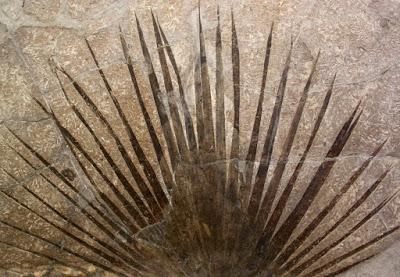 Am I following a palmetto?
Am I following a palmetto?
Sabal palmetto (source).
I’m intent on learning more about palms, as I decided to follow a palm tree this year (unfamiliar with tree-following? click on the link). My tree has a name, Sabalites, but what kind of palm is it? No one is sure. There are lots of choices—the palm family (Arecaceae) is large and diverse. It includes five subfamilies, 16 tribes, 2500 species, and many products consumed by humans: coconuts, dates, oil, betel chew, rattan and more. Most palms grow in tropical or subtropical regions, and occasionally in deserts.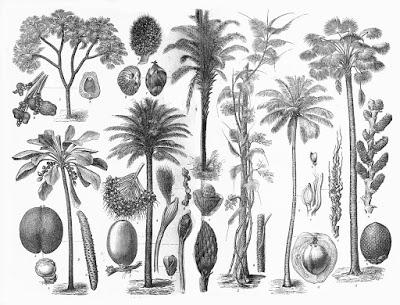
Selected palms of the world; click on image to view details (source).
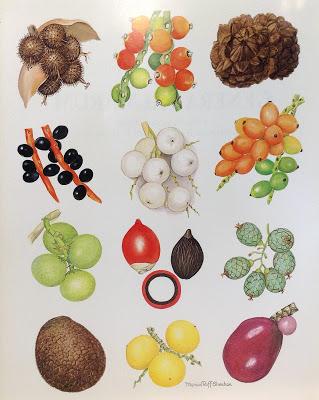
Palm fruit are beautiful as well as delicious (Dransfield et al. 2008).

Desert fan palms near Twentynine Palms, California (source).
When I lived in California, I was familiar with palm trees—specifically the ones planted along highways and in cities, and the native fan palms of desert oases, Washingtonia filifera. Then I moved to Wyoming where currently it’s much too cold for palms. However, fifty million years ago they lined the shores of huge lakes in the southwest part of the state. Even though their leaves are beautifully preserved in rocks of the Eocene Green River Formation (more here), no one is sure what kind of palms they were. Since I started following this tree, I’ve learned that plant fossil identification is really tough. Even the most challenging living plants are easy compared to fossilized ones.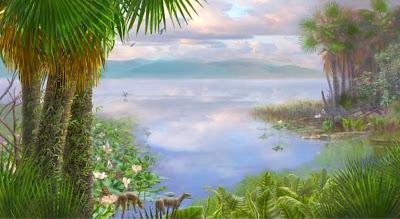
Fossil Lake of Early Eocene Wyoming (Chicago Field Museum).
In 1870, geologist Ferdinand Vandeveer Hayden’s exploratory expedition stopped near Green River Station, Wyoming, where they found lots of fossils. Some looked very much like palm leaves. In the expedition report, staff paleontologist Léo Lesquereux assigned them to Flabellaria Eocenica. I don’t know why … modern day Flabellaria is not a palm, nor do the leaves resemble palm leaves.
Later, Hayden sent the fossils to paleontologist John S. Newberry of Columbia College, who decided they looked enough like today’s palmettos, genus Sabal, to call them Sabal powellii (I presume in honor of geologist John Wesley Powell, then Director of the US Geological Survey, but I haven’t been able to confirm this). The Powell palmetto was one of ten new fossil plant species from the Green River area published by Newberry in 1882.
8. SABAL POWELLII, n. sp. Leaves of medium size, 4 or 5 feet in diameter, petiole smooth, unarmed, terminating above in a rounded or angular area, from which the folds diverge; beneath concavely narrowing to form a spike 3 to 4 inches in length; rays about fifty, radiating from the end of the petiole, perhaps sixty in the entire leaf, compressed to acute wedges where they issue from the petiole, strongly angled and attaining a maximum width of about 1 inch; nerves fine, about twelve stronger ones on each side of the keel, with finer intermediate ones too obscure for enumeration. Formation and locality. — Eocene strata. Green River Station, Wyoming.Why did Newberry conclude that these fossils were palmettos? Because the leaves are clearly costapalmate. (Yes, this is an esoteric term, but the concept is easy and useful.)
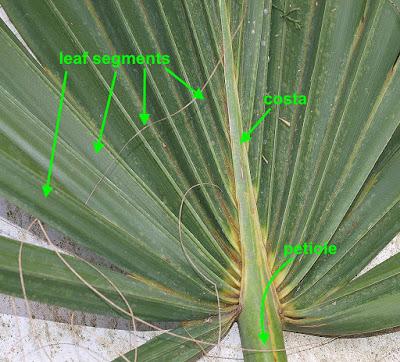
Costapalmate leaf of the Puerto Rican hat palm, Sabal causiarum (source).
Palm leaves are huge, with blades divided into many narrow segments arranged in several different patterns. In palmate leaves, segments fan out from the base of the blade—like fingers from the palm of a hand. In costapalmate leaves, the leaf stem (petiole) extends up into the blade to form a costa, where leaf segments are attached. The costa is only visible on the underside of the leaf, and from above, leaves look palmate. [Here’s a helpful webpage devoted to costapalmate palm leaves.]In a paper about extinct floras of North America (1898), Newberry included a photo of a Wyoming palm leaf fossil with an obvious costa. “In the figures given, that on Pl. LXIII, fig. 6, represents the under side of the leaf at its base, showing [a] pointed spike [costa] formed by the prolongation of the petiole.”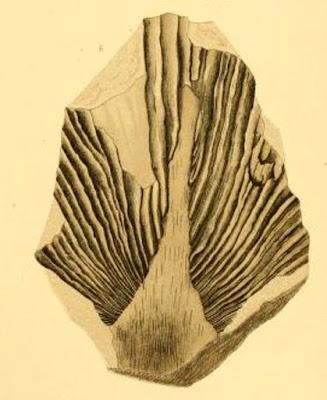
From Newberry 1898; no scale provided (leaves can reach 4-5 feet across).
Unfortunately, costas are not unique to palmettos, and in 1930, paleobotanist Edward W. Berry overrode Newberry’s decision, renaming the fossils Sabalites powellii:[the leaves] “are superficially much like the leaves of the existing species of Sabal, and their northern range appears to afford some corroboration of such a relationship, but this is by no means established, and it appears to me to be a better practice to refer such remains to the form* genus Sabalites rather than to Sabal.”[*In form classification, fossilized organisms or their fragments are classified based on appearance, not biological relationships. If different parts of a single species are not obviously from the same source, they may end up as different form species or even genera.]
Robert Read and Leo Hickey agreed with Berry in their 1972 Revised Classification of Fossil Palm and Palm-like Leaves. They were adamant that leaves alone are insufficient evidence:
“Numerous similarities in the form and gross external features of [fossil] palm leaves make it difficult or impossible to assign them to modern genera based only on their external morphology. The uncertainty … becomes even greater with the limited, incomplete collections available to the paleobotanist. A modern specialist might speculate that a given fossil closely resembled a modern genus such as Sabal, Geonoma or Thrinax. Such a suggestion would be debatable since it is almost impossible to distinguish these genera … without seeing flowers, fruit or other diagnostic characters. Forced identifications with modern genera contribute nothing to evolutionary theory but give instead a confused picture of the floristics of the geological record. Since it is very difficult to identify specimens of modern palms accurately from their leaves alone, no attempt should be made to place fossil palm fragments in genera of modern palms unless unquestionably identifiable with them.”
Maybe we shouldn’t give up just yet. After all, thousands of fossils are collected from the Green River Formation every year! Maybe some will reveal the true identity of Sabalites powellii. There’s reason for hope. Paleobotanist Sarah Allen has been working nearby on another fossil palm, in the Bridger Formation, and has enough fossils—leaves, flowers and even pollen—to confidently assign the trees to Phoenix, the genus that includes today’s date palms (Allen 2015). Will we be so lucky with Sabalites? Already its fossils include not just leaves, but also apical buds, flowers, inflorescences (flower clusters), and even inflorescences attached to leaves. Are more discoveries likely? When I visit the remains of Fossil Lake later this year, I'll look for some experts and ask them what they think.
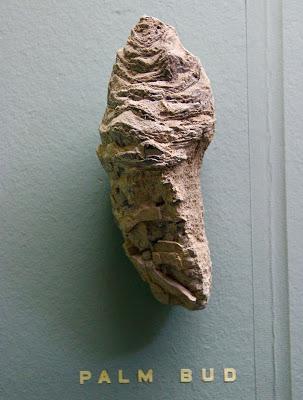
Fossil terminal bud, from the Green River Formation (in palms, leaves originate from a single terminal bud at the top of the trunk); University of Wyoming Geology Museum.
Personally, I hope paleobotanists find that Sabalites powellii is indeed a palmetto, and that they resurrect Newberry’s Sabal powellii. “Powell palmetto” has such a nice ring to it ...

We’re off to Fossil Lake to see the Powell palmettos!
Sources
Thanks to the Biodiversity Heritage Library for providing easy access to older paleontological literature, and to Mike for continued guidance in paleontology.
Berry, EW. 1930. A flora of Green River age in the Wind River basin of Wyoming. USGS Professional Paper 165: 67.
Dransfield, J., et al. 2008. Genera Palmarum, the evolution and classification of palms. University of Chicago Press.Newberry, JS. 1882. Brief descriptions of fossil plants chiefly Tertiary. Proceedings US National Museum 5: 504.
Newberry, JS (A. Hollick, ed.). 1898. The later extinct floras of North America. Washington: Government Printing Office.
Read, RW. and Hickey, LJ. 1972. Revised classification of fossil palm and palm-like leaves. Taxon 21:129-137.
